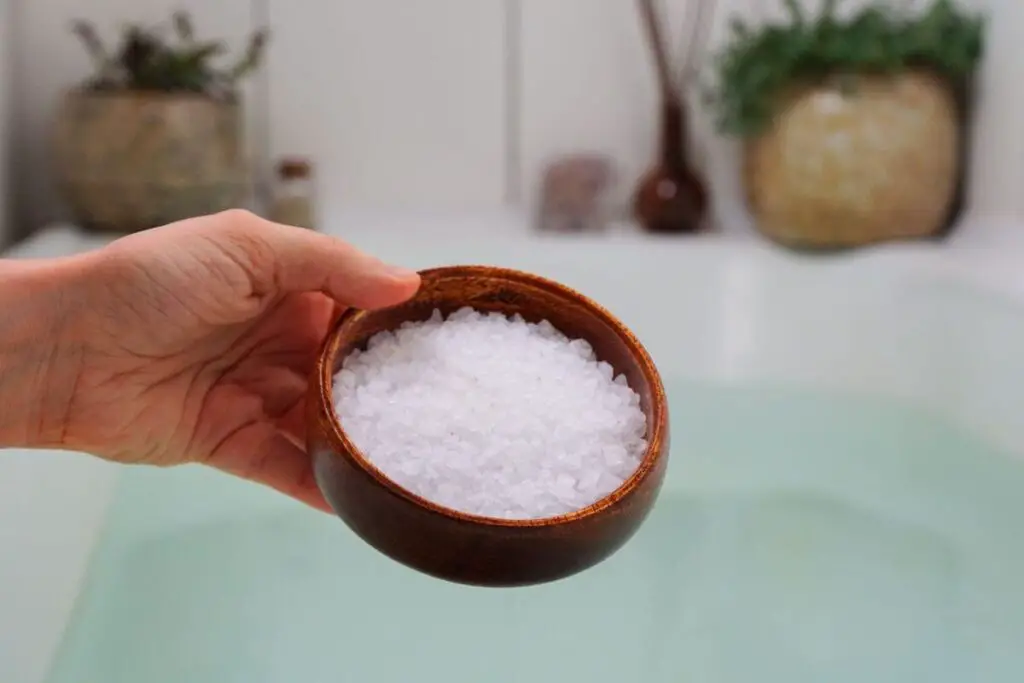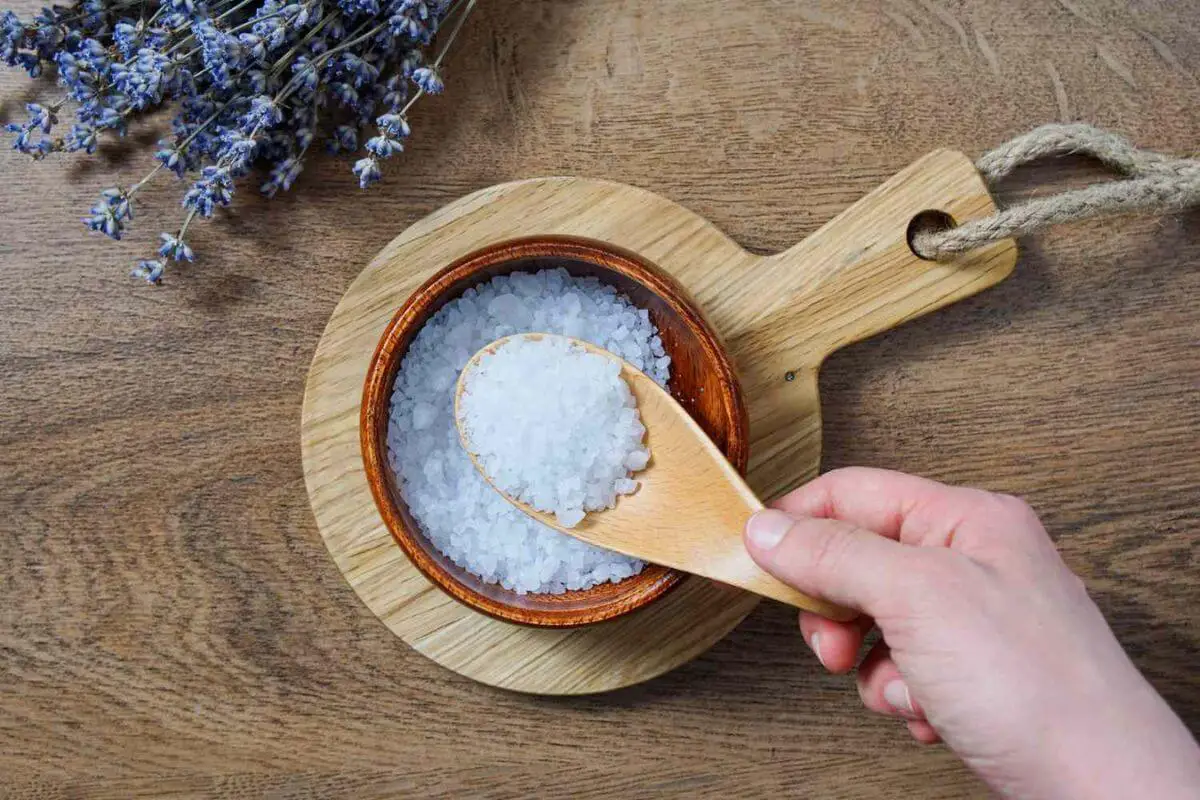Introduction: Embracing Nature’s Soothing Remedy
The aftermath of a sun-soaked day often reveals more than just a radiant tan – it may bring the discomfort and redness of sunburn. Amid the plethora of remedies, the age-old practice of indulging in an Epsom salt bath has emerged as a popular choice for soothing sunburn symptoms. In this comprehensive guide, we embark on a journey to explore the science behind Epsom salt baths and unveil their efficacy as a natural remedy for sunburn relief.
Understanding Epsom Salt: A Mineral Marvel
Epsom salt, scientifically known as magnesium sulfate, is a compound composed of magnesium, sulfur, and oxygen. Despite its name, Epsom salt is not a conventional salt but a mineral compound celebrated for its crystalline structure. With a historical presence in wellness practices spanning centuries, Epsom salt has garnered recognition for its potential therapeutic benefits.

The Potential Benefits of Epsom Salt Baths for Sunburn:
1. Anti-Inflammatory Properties:
- Epsom salt is believed to harbor anti-inflammatory properties, presenting a potential solution for reducing inflammation associated with sunburn. The magnesium content in Epsom salt is thought to play a pivotal role in modulating inflammatory responses, offering a natural and holistic approach to calming irritated skin.
2. Pain Relief:
- Beyond its anti-inflammatory effects, the soothing nature of an Epsom salt bath extends to pain relief. Immersing sunburned skin in warm water infused with dissolved Epsom salt may provide relief and alleviate the discomfort commonly associated with sunburn.
3. Skin Hydration:
- Epsom salt baths contribute to skin hydration, a critical aspect of sunburn recovery. Adequately hydrated skin is better equipped to heal, potentially minimizing excessive peeling and supporting the skin’s innate healing processes.
4. Magnesium Absorption:
- A key component of Epsom salt, magnesium is renowned for its potential benefits for the skin. While scientific evidence is somewhat limited, there is a prevailing belief that the skin can absorb magnesium during an Epsom salt bath, contributing to overall skin health and well-being.
How to Prepare an Epsom Salt Bath for Sunburn Relief:
Choose High-Quality Epsom Salt:
Opt for pure Epsom salt without additives or fragrances to ensure a wholesome and effective bathing experience.
Measure Appropriately:
Follow recommended guidelines, typically adding one to two cups of Epsom salt to a standard-sized bath for optimal relief.
Dissolve Thoroughly:
Ensure the Epsom salt dissolves completely in warm water before immersing yourself. This guarantees the even distribution of the salt and its potential benefits across your skin.
Soothing Additions (Optional):
Consider enhancing the soothing effects by adding natural ingredients such as aloe vera or chamomile. Exercise caution to avoid ingredients that might exacerbate sunburned skin.
Gentle Patting, Not Rubbing:
After the bath, adopt a gentle patting motion to dry your skin instead of rubbing. This minimizes additional irritation to the sunburned areas.
Cautions and Considerations:
While Epsom salt baths present a promising avenue for sunburn relief, it is crucial to exercise caution and consider individual factors:
1. Consultation with a Healthcare Professional:
- In cases of severe sunburn or if accompanied by other symptoms, consulting a healthcare professional is paramount. Epsom salt baths should complement, not replace, medical advice.
2. Skin Sensitivity:
- Individuals with sensitive skin should approach Epsom salt baths with caution. Conducting a patch test before full immersion can help ensure there are no adverse reactions.
3. Avoiding Hot Water:
- While warm water is recommended, excessively hot water can exacerbate sunburn. Maintaining a moderate water temperature is essential to avoid additional discomfort.
4. Hydration and Sunscreen:
- Epsom salt baths should be viewed as a supplementary measure rather than a substitute for proper hydration and sunscreen use. Staying hydrated by drinking water and using sunscreen remains crucial in preventing future sunburn.
Conclusion: A Time-Honored Tradition with Cautionary Wisdom
In conclusion, Epsom salt baths have rightfully earned their place in the array of home remedies for sunburn relief. The potential benefits, ranging from anti-inflammatory properties to pain relief, position them as a favored choice for those seeking natural solutions. However, it is imperative to approach this tradition with caution, considering individual skin sensitivity and the severity of the sunburn.
For individuals seeking solace in a soothing Epsom salt bath after a sun-drenched day, moderation, proper preparation, and an awareness of personal skin reactions are key. As with any remedy, listening to your body, consulting healthcare professionals when needed, and embracing the time-honored practice of finding solace in a relaxing soak ensure a balanced and holistic approach.
Elevating the Experience: Tips for Maximum Epsom Salt Bath Relief
To truly make the most of your Epsom salt bath experience and amplify its potential benefits for sunburn relief, consider incorporating the following tips into your soothing ritual:
1. Cool Compress Before the Bath:
- Begin by soothing sunburned areas with a cool compress. This preliminary step helps reduce initial inflammation and prepares your skin for the therapeutic Epsom salt soak.
2. Add Natural Oils for Extra Nourishment:
- Elevate the hydrating effects of your bath by introducing natural oils like jojoba or coconut oil. These oils not only enhance the moisturizing impact but also provide additional nourishment to sun-exposed and dehydrated skin.
3. Mindful Breathing and Relaxation:
- Transform your bath into a haven for relaxation. Practice mindful breathing and allow yourself to unwind. Stress reduction is not only beneficial for your overall well-being but also complements the physical benefits of the Epsom salt bath.
4. Incorporate Healing Herbs:
- Take your soak to the next level by adding herbs renowned for their skin-soothing properties. Calendula, lavender, and chamomile can be infused into the bathwater, amplifying the calming effects on sunburned skin.
5. Stay Hydrated Throughout:
- Don’t forget to hydrate from the inside out. Ensure you’re drinking water before, during, and after your Epsom salt bath. This internal hydration supports overall skin health, complementing the external benefits of the bath.
6. Post-Bath Skincare Routine:
- After the bath, extend the pampering by applying a gentle, hydrating moisturizer. This locks in the moisture absorbed during the soak, leaving your skin feeling refreshed. Opt for products with minimal fragrances to avoid potential irritation.
7. Repeat as Needed:
- Depending on the severity of your sunburn, feel free to repeat Epsom salt baths as needed. Regular but mindful use can contribute to ongoing relief and support your skin’s natural recovery process.
Additional Considerations:
1. Individual Tolerance Levels:
- Pay attention to how your skin responds to the Epsom salt bath. If you experience any irritation or discomfort, it’s essential to discontinue use and consult with a healthcare professional.
2. Gradual Reintroduction of Sun Exposure:
- After treating your sunburn, gradually reintroduce sun exposure while taking precautions. This includes using sunscreen and protective clothing. Avoid prolonged exposure during peak hours to prevent further damage.
3. Holistic Sunburn Care:
- Remember that Epsom salt baths are just one part of a holistic approach to sunburn care. Stay vigilant about sun protection, manage pain with over-the-counter remedies if necessary, and seek medical advice for severe cases.
In conclusion, the tradition of indulging in an Epsom salt bath for sunburn relief carries both historic significance and potential therapeutic benefits. By infusing intention into the experience, incorporating natural elements, and prioritizing overall skin health, individuals can turn a simple bath into a comforting ritual.
As with any skincare practice, moderation and attentiveness to individual needs are paramount. Whether you’re seeking relief from sunburn or simply unwinding after a day under the sun, let the Epsom salt bath be a comforting companion on your journey to radiant, healthy skin.
Frequently Asked Questions (FAQs) About Epsom Salt Baths for Sunburn Relief
Can Epsom salt baths really help with sunburn?
Answer: Yes, Epsom salt baths are believed to offer relief for sunburn. The magnesium sulfate in Epsom salt is thought to have anti-inflammatory properties that can potentially reduce redness and soothe sunburned skin.
How much Epsom salt should I use in a sunburn bath?
Answer: The recommended amount of Epsom salt for a sunburn bath is typically one to two cups per standard-sized bathtub. Ensure that the salt dissolves completely in warm water for even distribution.
How often can I take Epsom salt baths for sunburn relief?
Answer: The frequency of Epsom salt baths for sunburn relief can vary. It’s generally safe to take them daily or as needed for comfort. However, individual tolerance levels and skin sensitivity should be considered.
Are there any side effects of using Epsom salt for sunburn?
Answer: Epsom salt baths are generally safe, but individuals with sensitive skin may experience irritation. It’s essential to conduct a patch test before full immersion and discontinue use if any adverse reactions occur.
Can I add other ingredients to my Epsom salt bath for sunburn?
Answer: Yes, you can enhance the benefits by adding natural oils like jojoba or coconut oil, or infusing calming herbs like chamomile. However, avoid ingredients that may irritate sunburned skin, and choose additives mindfully.
How long should I soak in an Epsom salt bath for sunburn relief?
Answer: A typical Epsom salt bath for sunburn relief lasts around 15 to 20 minutes. Ensure the water temperature is comfortably warm, and avoid hot water, which can exacerbate sunburn.
Can Epsom salt baths prevent peeling after sunburn?
Answer: While Epsom salt baths can contribute to skin hydration, preventing peeling entirely may not be guaranteed. Proper hydration, gentle skincare, and sun protection are essential components of minimizing peeling.
Is it safe for children to take Epsom salt baths for sunburn?
Answer: Epsom salt baths are generally considered safe for children, but it’s crucial to use a lower Epsom salt concentration and closely monitor the duration of their bath. Consult with a pediatrician if there are concerns.
Can Epsom salt baths replace medical treatment for severe sunburn?
Answer: Epsom salt baths can provide relief for mild to moderate sunburn, but severe cases may require medical attention. Consult with a healthcare professional for appropriate guidance and treatment.
Are there any alternatives to Epsom salt for sunburn relief?
Answer: Alternatives to Epsom salt for sunburn relief include cool compresses, aloe vera gel, and over-the-counter creams with ingredients like hydrocortisone. Experiment with various remedies to find what works best for your skin.
Feel free to reach out if you have additional questions or require further clarification on Epsom salt baths and sunburn relief.



